For Sunday December 27, 2020
Lectionary Readings (Revised Common Lectionary, Year B)
Isaiah 61:10–62:3
Psalm 148
Galatians 4:4–7
Luke 2:22–40
NOTE: Debie Thomas is taking her annual two-week break, and will return with her lectionary essay on January 3. Daniel B. Clendenin founded Journey with Jesus in 2004. To learn more about Dan, click here.
Believers will face many distractions this holiest of weeks, chief among them trying to celebrate Christmas during a global pandemic. Retailers will bombard us with the lie that we can spend our way to happiness. Family gatherings will provoke stress and strain. Therapists will warn us about overload. For me, though, one of the biggest challenges to Christmas faith is sentimentality — it's hard not to dote on our "angelic" kids in oversized bathrobes and "shepherds" with towels for turbans.
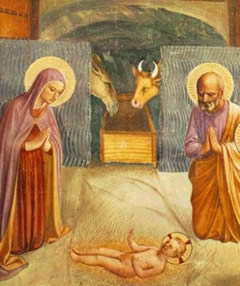 |
|
Fresco of the Christ Child, c. 1300, by Fra Angelico.
|
The Christmas Story is a post-modernist's worst nightmare of a Grand Narrative — the stupendous claim that "God was in Christ reconciling the cosmos to himself" (2 Corinthians 5:19). Elsewhere Paul calls it a "profound mystery" (Ephesians 5:32). Authentic faith requires genuine astonishment at such a proclamation, of the sort that appreciates the border lands of disbelief — disbelief in the sense of a contronym, that is, a single word that can have contradictory meanings.
In his book A Public Faith (2011), the Yale theologian Miroslav Volf tells how the Canadian philosopher Charles Taylor once heard Mother Theresa explain why she served the poor. She often complained, "people say we're social workers. We're not social workers! We're Christians who worship Jesus as Lord and therefore serve people made in the image of God." Taylor, a practicing Catholic, thought to himself: "I could have said that, too!" Upon further reflection, he then wondered, "But could I have meant it?" (emphasis his).
At Christmas we confess a creed, but with Taylor, I ask myself, "do I mean it?"
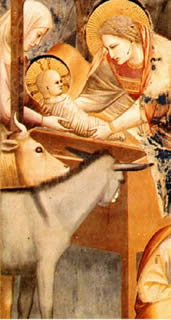 |
|
Fresco of the Christ Child, c. 1300, by Giotto.
|
Annie Dillard lamented how casually we confess our faith. In her book Teaching a Stone to Talk, she writes, "Does anyone have the foggiest idea of what sort of power we so blithely invoke? Or, as I suspect, does no one believe a word of it? The churches are children playing on the floor with their chemistry sets, mixing up a batch of TNT to kill a Sunday morning. It is madness to wear ladies' straw hats and velvet hats to church; we should all be wearing crash helmets! Ushers should issue life preservers and signal flares; they should lash us to our pews! For the sleeping God may awake someday and take offense, or the waking God may draw us to where we can never return."
Britain's former Poet Laureate John Betjeman (1906–1984), a practicing Anglican (and a very unhappy student under his young tutor CS Lewis at Oxford), held his confessional feet to the intellectual fire. In the first five stanzas of his poem "Christmas," Betjeman describes "sweet and silly Christmas things" like saying "the church looks nice," syrupy greetings like "Merry Christmas to you all!", and "hideous" gifts like bath salts and cheap perfume.
In his last three stanzas, though, Betjeman ups the ante about as high as it can go.
And is it true,
This most tremendous tale of all,
Seen in a stained-glass window's hue,
A Baby in an ox's stall?
The Maker of the stars and sea
Become a Child on earth for me?And is it true? For if it is,
No loving fingers tying strings
Around those tissued fripperies,
The sweet and silly Christmas things,
Bath salts and inexpensive scent
And hideous tie so kindly meant,
No love that in a family dwells,
No carolling in frosty air,
Nor all the steeple-shaking bells
Can with this single Truth compare —
That God was man in Palestine
And lives today in Bread and Wine.
Some people reject the Christmas story as false, observes Kevin Gardner in Faith and Doubt of John Betjeman (2006), even though they might wish it was true. The British writer Julian Barnes didn't believe in God, but nonetheless said that he still misses him. Betjeman, on the other hand, confessed his faith, albeit with candor about the stupendous claim being made.
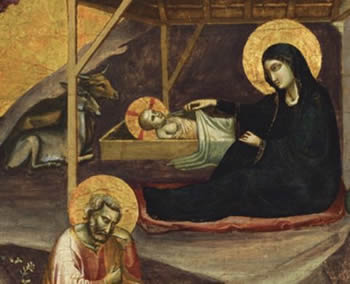 |
|
Nativity, 1325, by Taddeo Gaddi.
|
The church does many things — intellectual inquiry, moral development, community building, peace-making, interfaith dialogue, hospitals and schools, art, music, and care for the poor. But none of these are unique to the church; you can find them all in many other places. What distinguishes the church from all these other worthy pursuits, as Mother Theresa observed, is our liturgical confession that Jesus, the Christ Child, is Lord.
And so every Sunday, to take just one example, our priests raise the bright red gospel book high above their heads as they process down the center aisle, and after placing the book on the altar they prostrate themselves before the Mystery. For the gospel reading they repeat the act in reverse, processing back down the aisle into the middle of the congregation, at which point we all stand up and pivot toward the gospel and confess, "Glory to you, Lord Christ!"
If you did that with a volume of Shakespeare people would think you're nuts; and we too are nuts to say what we say at Christmas unless, as Betjeman wrote, we're confessing an "incomparable Truth" that invites us not just to honor Jesus but to bow down and worship him. After considering whether the earliest believers were "deceived or deceiving" (Pascal), we all decide whether we too can make that ancient confession.
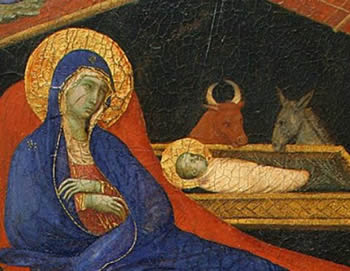 |
|
The Birth of Christ, c. 1308, by Duccio di Buoninsegna.
|
Matthew's birth narrative describes a series of five dreams to tell this stupendous story. Luke appeals to the Spirit-inspired songs of Mary, Zechariah, and Simeon. John incorporates Greek philosophy about the Logos, connecting creation in Genesis with redemption in Jesus: "In the beginning God created… In the beginning was the Word." What God lovingly created he will assuredly redeem.
This week many of us will sing the Christmas carol “Good Christians All Rejoice,” with its words, “Ox and ass before him bow, and he is in the manger now; Christ is born today! Christ is born today!” But the gospels never mention animals at the manger, even though they became common in the later art and iconography of the nativity. How did they enter the story? What do they signify?
The earliest mention of animals at the nativity is the Gospel of Pseudo-Matthew from the eighth century: "And on the third day after the birth of our Lord Jesus Christ, Mary went out of the cave, and, entering a stable, placed the child in a manger, and an ox and an ass adored him. Then was fulfilled that which was said by the prophet Isaiah, 'The ox knows his owner, and the ass his master's crib.' Therefore, the animals, the ox and the ass, with him in their midst incessantly adored him. Then was fulfilled that which was said by Habakkuk the prophet, saying, 'Between two animals you are made manifest.'"
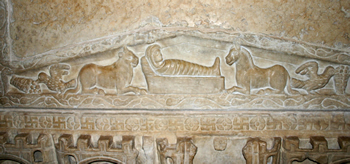 |
|
The Ox and Donkey worship Jesus, 4th century Roman sarcophagus.
|
Others credit Saint Francis of Assisi with creating the first manger scene with live animals. Even more interesting is a Christian sarcophagus from fourth-century Rome that depicts an ox and ass worshipping the Christ Child. By the sixteenth-century it's hard to find a manger scene without them. The "incessant adoration" of these brute beasts challenges us to make our own confession this year, and with Charles Taylor to wonder whether we really mean it.
Dan Clendenin: dan@journeywithjesus.net
Image credits: (1–4) ScriptoriumDaily.com; and (5) Wikipedia.org.





